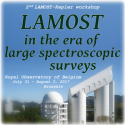Speaker
Dr
Ji-Wei Xie
(Nanjing University)
Description
With the discoveries of thousands of planets, the Kepler mission has brought revolutions to the exoplanet researching field, which is advancing from studying individual exoplanets to characterizing planet populations. However, making any reliable statistical inference with a large Kepler planet sample is seriously limited by the lack of accurate stellar parameters for the majority of the targets. With 4000 fibers and 5 degrees of diameter field of view, the LAMOST is uniquely positioned to perform a systematic spectroscopic survey of Kepler target stars. The LAMOST-Kepler survey provides a complete and unbiased sample to perform statistical inference on planet distribution and correlations with host properties, which provides new insights on planet formation and evolution. This talk will review several such statistical studies, showing the impact of LAMOST on the study of Kepler planets. In the future, LAMOST will continue to play such a crucial role in the TESS era.
Primary author
Dr
Ji-Wei Xie
(Nanjing University)
Co-author
Dr
Subo Dong
(Peking University)

